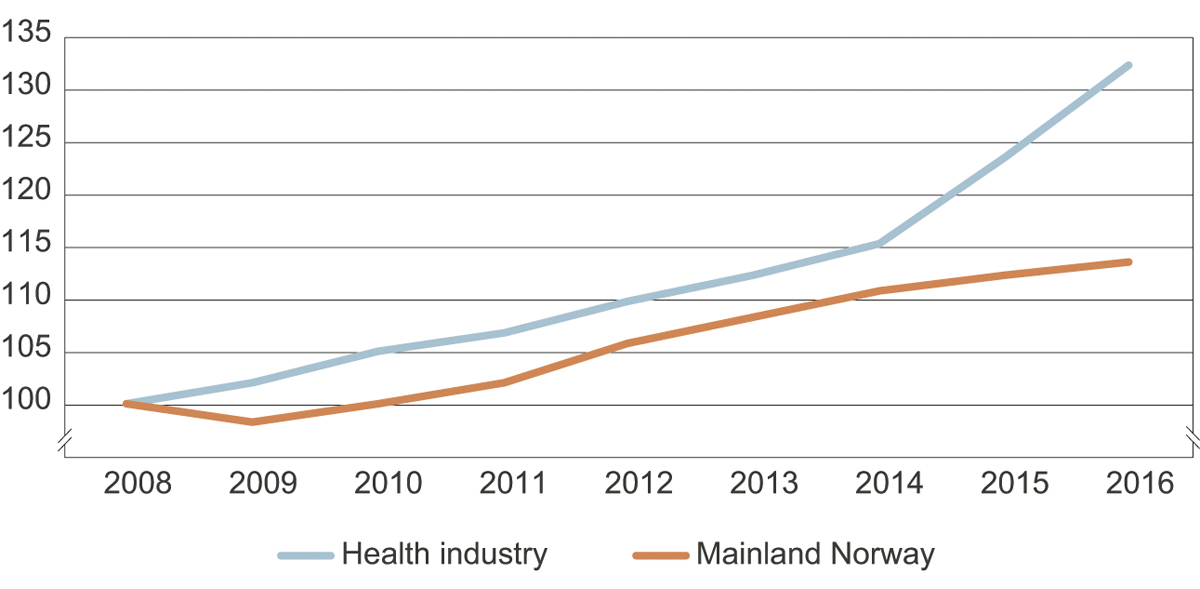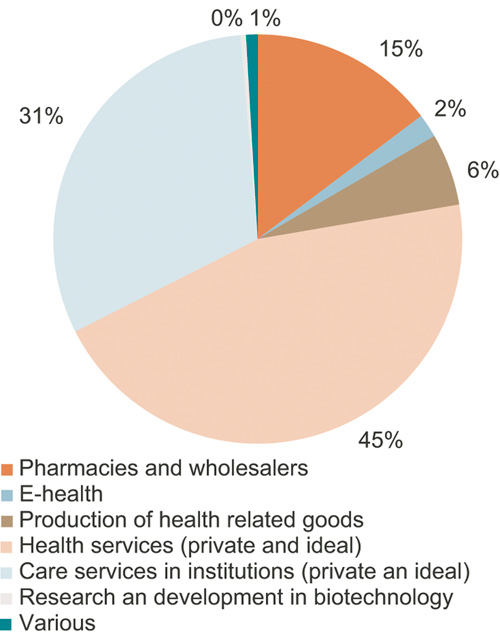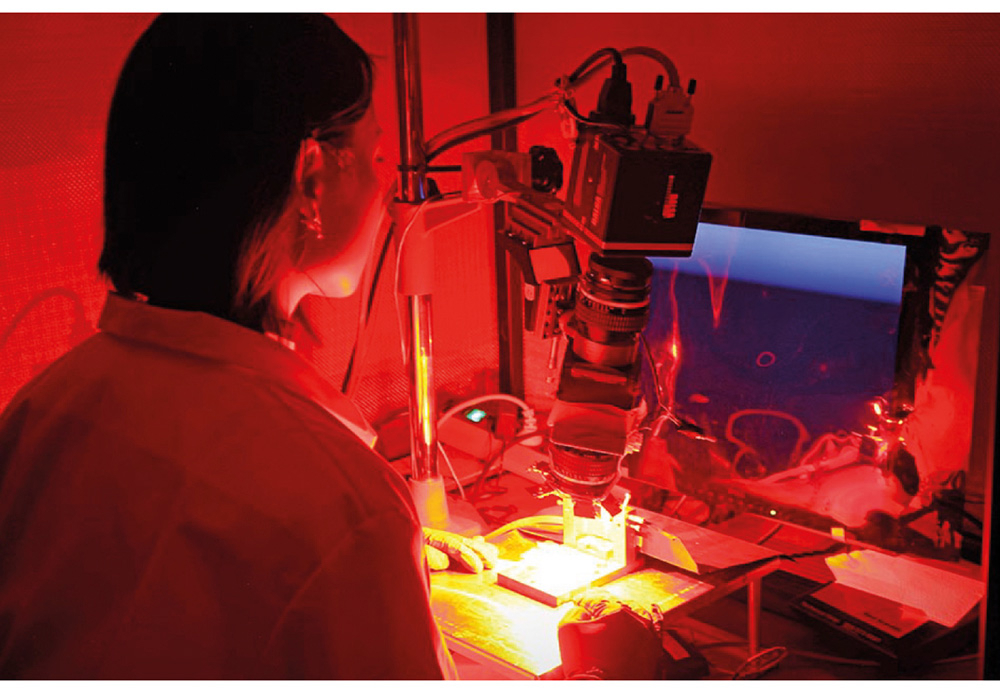1
The main objective of the white paper
The main objective of the white paper is to contribute to improved competitiveness in the Norwegian health industry, and at the same time contribute to a more sustainable health and care service, through more efficient prevention, treatment and care.
The Government’s industrial policy is well suited to the health industry. The main challenges for further growth and development in the Norwegian health industry are related to the demand in the domestic market. Dealing with the biggest obstacles and barriers in the domestic market will strengthen the health industry’s competitiveness.
Enterprises that want to corporate with, and deliver products and services to the public health and care sector, should know the needs of the sector and deliver solutions that increase its sustainability.
The patient’s health services must be developed within a sustainable resource framework. Business and industry have an impotant role in developing the sustainable solutions needed. An attractive domestic market for the health industry will form the basis for increased value creation and more profitable jobs in Norway. The health industry can contribute to achieve both health policy goals and industrial policy goals.
About the industry
The health industry consists of enterprises developing and producing goods and services for use in private and public health and care services, or in prevention, diagnostics, treatment and rehabilitation.
Value creation in the health industry constitutes around three per cent of Norway’s mainland economy. In recent years, growth in the health industry has exceeded growth in the mainland economy. The health industry employed around 100,000 people in 2016, an increase of 18 per cent since 2008. The growth in employment has been lower than the growth in value creation, which means that the value creation per employee has increased.

Figure 1.1 Value creation, indexes, constant prices, 2008=100
Source Statistics Norway and Ministry of Trade, Industry and Fisheries

Figure 1.2 Employment 2016. Share of total
Source Statistics Norway and Ministry of Trade, Industry and Fisheries
Good starting point, but potential to do better
The starting point for the Norwegian health industry is good, but there are barriers that may make it difficult for enterprises and the industry as a whole to grow.
Investments have been made over many years: in education, research and innovation. Norway is an open and trusting society with an evidence-based health and care service of high quality and with a high coverage ratio. These advantages are preconditions for a vigorous and innovative health industry.
In general, Norwegian business and industry enjoys good framework conditions, with an effective tax system, a well-developed infrastructure and political stability. By international standards, our highly educated workforce have relatively low wages. Norway is also considered a country in which it is relatively easy to run business.
The challenges for the health industry are related to the culture of cooperation between the business sector, the higher education sector and the public health and care sector. The lack of clarity regarding public administration’s responsibility for developing and implementing new solutions, particularly in the area of e-health, and the public health and care service’s management of public procurements creates challenges.
The number of industry-funded pharmaceutical clinical trials has decreased in recent years. Companies developing e-health solutions and medical equipment need better access to test facilities. Access to health and register data is challenging for the health industry. There is also a potential for increased commercialisation of research and of ideas generated by the health and care sector. Many Norwegian health industry enterprises find the process of commercialisation and obtaining sufficient funding challenging. Experience and input from the industry show that a well-functioning domestic market is important for Norwegian enterprises’ success in global markets.
The Government’s health industry policy
The Government wants to improve the competitiveness of the Norwegian health industry and at the same time contribute to a more sustainable health and care service, through more efficient prevention, treatment and care. Developing better health and care services requires constructive cooperation with the health industry, both at a national and international level. This will enable an innovative and competitive Norwegian health industry to help achieve health policy goals. Better cooperation can also form the basis for growth in the Norwegian health industry. The health policy goal of good, efficient patient treatment will indirectly contribute to reaching the industrial policy goal of greater overall value creation in the Norwegian economy within a sustainable framework.
The starting point for the Norwegian health industry is good, but there are barriers that may make it difficult for individual enterprises and the industry as a whole to grow. Identifying these barriers is important to improve the competitiveness of the Norwegian health industry. Positive development in the areas that are particularly challenging will help us to reach both industrial policy and health policy goals. Government policies to achieve this, as presented in the following chapters, are:
Establish a stronger culture for contact and dialogue between business and industry, the higher education sector, and the public health and care sector
Work to ensure good business conditions in general, and for research and development in particular
Make the public health and care sector an attractive partner for business and industry
Facilitate more commercialisation of medical and health-related research and of ideas generated within the health and care sector
Stronger culture for cooperation
The business sector can help develop better solutions and more efficient use of resources in the health sector. They can help the health service and the public health administration to reach their goals. It is the responsibility of management in the health and care services to benefit this potential. The Government wants a stronger culture for contact and dialogue between businesses and industry, the higher education sector, and the health and care sector.
Businesses and industry and the health and care sector have different responsibilities and interests. The health and care sector must be a demanding development partner and customer, and, at the same time, set high documentation requirements. Professionalism and reliability are fundamental. The Government expects the health and care service and the public health administration to have expedient principles and procedures for their cooperation with business and industry.
Chapter 6 of the white paper sets out the importance of management in creating the necessary culture for innovation and development in the health sector and the role of the business sector in this context. The chapter describes and discusses the role of the public and private sectors in developing new services, especially in ICT. It also describes the framework for cooperation with the business sector and different types of areas of cooperation.

Figure 1.3 The Intervention Center, Oslo University Hospital
Photo: The Intervention Center, Oslo University Hospital
Textbox 1.1 In order to ensure that the innovativeness, expertise and resources of the business sector generate greater benefits for the health and care sector, the Government will:
Emphasize the expectations of cooperation with the business sector in the assignment document for the regional health authorities and in the letter of allocation to the underlying agencies
Transfer responsibility, duties and staff linked to existing e-health solutions from the Norwegian Directorate of eHealth to Norsk Helsenett SF
Submit a new national health and hospital plan in which primary and secondary care integration, technology and competence are key elements
Continue to develop the funding system for hospitals in order to better support a coherent care pathway, use of new technology and innovation in service design
Develop the Health&Care21 Advisory Board as an arena for interaction for cooperation with the business sector
Assess how to develop innovation activities in the municipal health and care services
Ensure that the Norwegian State Housing Bank develops its advisory services to municipalities and industry in order to stimulate innovation when building community care facilities
Facilitate management development in innovation and business development, and ensure its inclusion in the new executive management programme in the specialist health service and municipal health and care services
Good conditions for business and industry
The Government pursues a industrial policy that facilitates growth and development in the business sector, including in the health industry. Good terms for running businesses ensure that labour and capital go where they get the biggest return.
Research and innovation help to renew and restructure the business sector and make it more productive. Since 2013, the Government has strengthened the nationwide business-oriented research and innovation schemes, and the health industry uses these schemes actively. The Government has a long-term plan for research and higher education which includes initiatives focusing on technology and restructuring of business and industry, which will be important for further growth and development also in the health industry.
The Government is working to achieve good terms for trade and market access and well-functioning capital markets. Sufficient access to capital in the different development phases for start-up companies is vital for growth. Figure 1.4 Research in biotechnology Photo: Christian Koehler/Centre for Digital Life Norway 
Textbox 1.2 In order to encourage further positive development in the health industry, the Government will:
Assess the report and recommendations made by the Capital Access Commission, including changes in the taxation of employee options in small, newly-established companies and evaluation of meeting places that connect entrepreneurs and investors
Study the potential for utilising any spare capacity in existing laboratories and infrastructure for testing and piloting at universities, university colleges and hospitals by making it available to business and industry and assessing possible incentives to that end
Submit an assessment of the institute sector’s role in the research and innovation system and of to what extent the sector is suitably adapted to meet the needs of the future
Map the potential for increasing interaction with the health industry in relevant parts of the institute sector
Clarify expectations that Innovation Norway’s assessments of the expertise and resources at its offices abroad, must emphasise the needs of the health industry and other emerging industries that may especially benefit from assistance to access international markets
Study whether the State should take on a coordinating role in joint international marketing of individual industries and research environments
Continue work on increasing Norwegian participation in EU programmes and take steps to enable Norwegian companies to participate in innovative procurements in other European countries
Perform a comprehensive review of the policy instruments in place for the business sector
Continue the prioritising on business-relevant research and innovation, the high level of support to policy instruments with the highest degree of innovation and efficiency, and continue the focus on the broad, nationwide schemes.
Attractive partner
The Norwegian public health and care service should be an attractive partner for Norwegian and international business. To succeed, the enterprises must know the service’s needs and be able to document effect, safety and cost efficiency. The enterprises must be familiar with the organisational, regulatory and ethical frameworks. The priority criteria and assessment and decision-making systems for introducing new solutions in the health and care service are important.
Chapter 8 of the white paper describes how the health and care service and the business sector cooperate on the different stages of the development process when new products, services and work processes are developed and introduced. The chapter discusses the different stages of development and introduction of new products, services and work processes. The Government wants to take steps to improve the interaction between the health and care services and different private and non-profit parties in the health innovation ecosystem. This will take place in the different phases from the needs analysis, through the development process, via procurement to implementation, distribution and evaluation of the product in clinical practice.

Figure 1.5 Health innovation ecosystem
Textbox 1.3 In order for the Norwegian public health and care service to be an attractive partner for Norwegian and international business, the Government will:
Facilitate increased use of innovative public procurements in the health and care service and the public health administration
Submit an action plan for clinical trials in 2020
Establish ‘one stop shop’ for clinical trials, by linking NorCRIN more closely to business and industry through a partnership model
Study how a combination of different research and innovation policy instruments can contribute to a more coherent process towards the implementation of new technology and new solutions in the health and care service
Introduce an indicator for clinical trials and consider implementation in the results-based funding system of research in the specialist health service
Introduce indicators for measuring innovation in the specialist health service and consider implementation in the results-based funding system of research in the specialist health service
Establish a platform for health data analysis to simplify access to health data for research and analysis purposes, while strengthening protection of privacy. Including enabling more active use of health data in the process of developing pharmaceuticals and medical technology
Take steps to ensure that more world-leading research communities are developed in Norway. A Life Science building is being built at the University of Oslo in conjunction with this work, which will ensure high quality and relevance in education and research
Strengthen the connection between the knowledge gaps identified in Nye Metoder (the national system for managed introduction of new health technologies within the specialist health service in Norway) and the use of electronic prescribing systems, medical quality registers and register-supported clinical trials (real world data)
Ensure that the Innovation Office at the Norwegian Medicines Agency has the ability to provide good regulatory advice to business and industry and the health service.
More commercialisation
The last chapter in the white paper looks at the terms for commercialisation of the results of medical and health-related publicly funded research and of ideas developed within the health and care sector. Commercialisation is about bringing ideas and inventions to market. Ideas and inventions that emerge through research and practice can and should benefit patients and society as a whole in the form of new goods and services and better work processes.
The Government’s ambition is to strengthen the work on commercialising the results of publicly funded research to an even greater extent. The Government believes there is potential for more commercialisation of medical and health-related research and ideas generated by the health and care sector.

Figure 1.6 Production of radiological drugs at Institute of Energy Technology
Photo: Institute for Energy Technology
Textbox 1.4 In order to strengthen the work on commercialisation, the Government will:
Consider incentives for commercialisation of research results in the higher education sector, and particularly consider implications for hospitals
Map whether better guidance is needed on intellectual property rights in the health industry or parts thereof
Map how entrepreneurship is taught and whether it needs to be strengthened in the education of health care professionals
Prepare an action plan for female entrepreneurs, to be completed in 2019